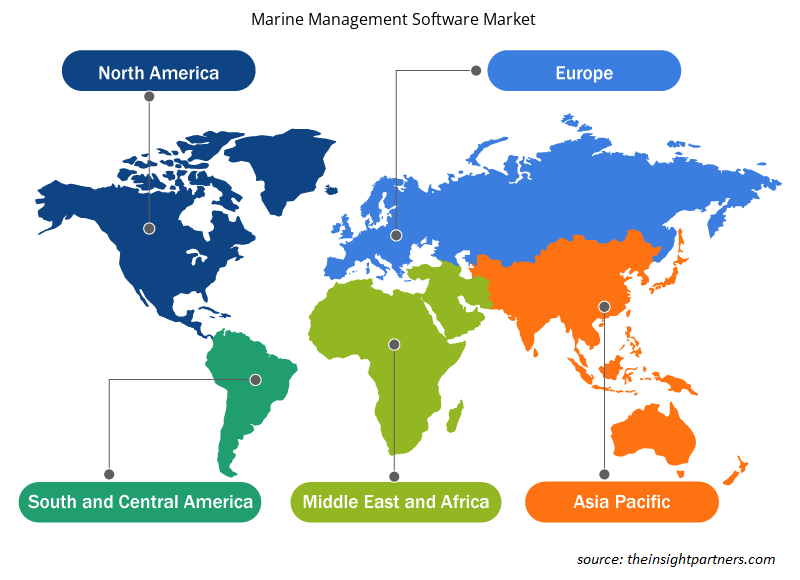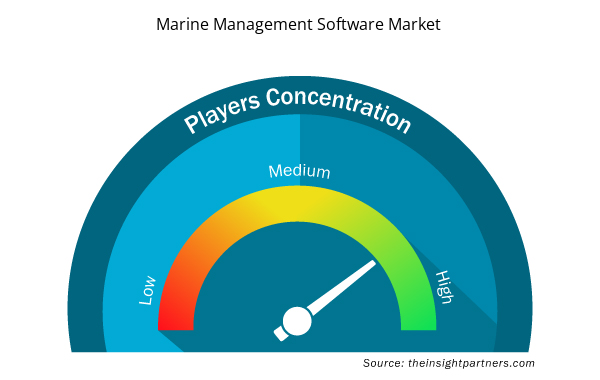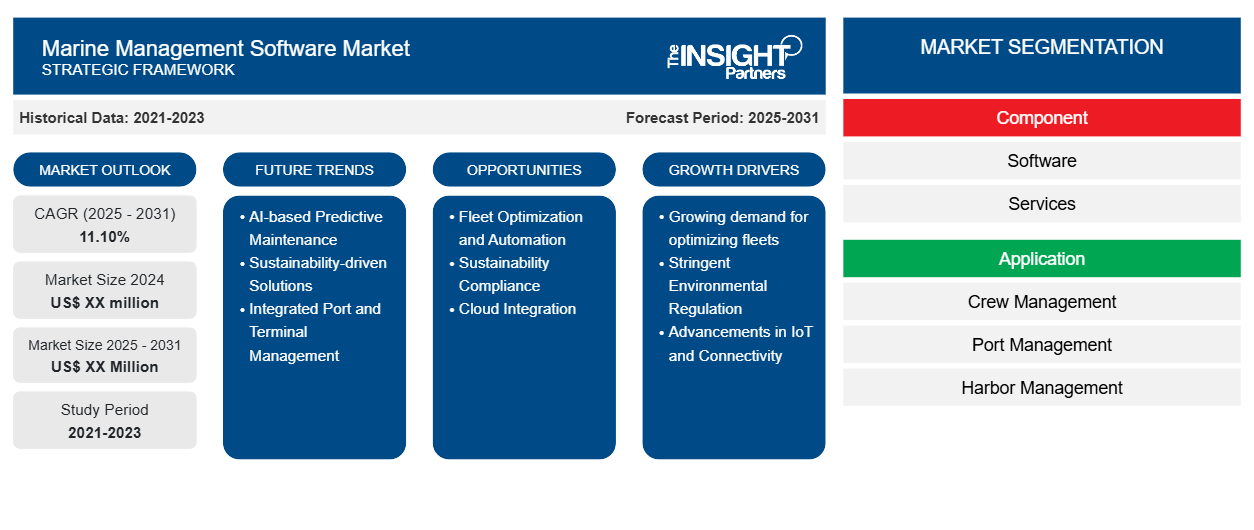من المتوقع أن يسجل سوق برمجيات إدارة البحرية معدل نمو سنوي مركب بنسبة 11.10٪ من عام 2024 إلى عام 2031، مع توسع حجم السوق من XX مليون دولار أمريكي في عام 2024 إلى XX مليون دولار أمريكي بحلول عام 2031.
يغطي تقرير سوق برامج إدارة الملاحة البحرية تحليلاً متعمقًا يعتمد على المكون (البرمجيات والخدمات)؛ والتطبيق (إدارة الطاقم، وإدارة الموانئ، وإدارة الموانئ، وإدارة الحجز، وإدارة الرحلات البحرية واليخوت)؛ والمستخدم النهائي (التجاري والدفاعي). وينقسم التحليل العالمي بشكل أكبر على المستوى الإقليمي والدول الرئيسية.
غرض التقرير
يهدف تقرير سوق برامج إدارة الملاحة البحرية الصادر عن The Insight Partners إلى وصف المشهد الحالي والنمو المستقبلي وأهم العوامل الدافعة والتحديات والفرص. وسيوفر هذا رؤى لمختلف أصحاب المصلحة في الأعمال التجارية، مثل:
- مزودي/مصنعي التكنولوجيا: لفهم ديناميكيات السوق المتطورة ومعرفة فرص النمو المحتملة، وتمكينهم من اتخاذ قرارات استراتيجية مستنيرة.
- المستثمرون: إجراء تحليل شامل للاتجاهات فيما يتعلق بمعدل نمو السوق، وتوقعات السوق المالية، والفرص المتاحة عبر سلسلة القيمة.
- الهيئات التنظيمية: لتنظيم السياسات ومراقبة الأنشطة في السوق بهدف تقليل الانتهاكات والحفاظ على ثقة المستثمرين ودعم سلامة السوق واستقرارها.
تجزئة سوق برامج إدارة الشؤون البحرية
عنصر
- برمجة
- خدمات
طلب
- إدارة الطاقم
- إدارة الموانئ
- إدارة الموانئ
- إدارة الحجز
- إدارة الرحلات البحرية واليخوت
المستخدم النهائي
- تجاري
- الدفاع
الجغرافيا
- أمريكا الشمالية
- أوروبا
- آسيا والمحيط الهادئ
- أمريكا الجنوبية والوسطى
- الشرق الأوسط وأفريقيا
قم بتخصيص هذا التقرير ليناسب متطلباتك
ستحصل على تخصيص لأي تقرير - مجانًا - بما في ذلك أجزاء من هذا التقرير، أو تحليل على مستوى الدولة، وحزمة بيانات Excel، بالإضافة إلى الاستفادة من العروض والخصومات الرائعة للشركات الناشئة والجامعات
- احصل على أهم اتجاهات السوق الرئيسية لهذا التقرير.ستتضمن هذه العينة المجانية تحليلاً للبيانات، بدءًا من اتجاهات السوق وحتى التقديرات والتوقعات.
عوامل نمو سوق برامج إدارة الشؤون البحرية
- الطلب المتزايد على تحسين الأساطيل: إن الحاجة إلى تحسين استخدام الوقود وخفض التكاليف لشركات الشحن تجبر برامج إدارة الأساطيل البحرية على توفير مراقبة الأساطيل وتحسين المسارات وجدولة الصيانة في الوقت الفعلي. وهذا يتيح لمشغلي الأساطيل استهلاك وقود أقل وإنتاج انبعاثات أقل وخفض النفقات الإجمالية للأساطيل. وبالتالي فإن البرامج المذكورة أعلاه لا غنى عنها للغاية في تبسيط الإدارة الفعالة للأساطيل.
- التنظيم البيئي الصارم: تم إصدار معظم القوانين البيئية، على سبيل المثال، منظمة الملاحة البحرية الدولية 2020، وقياسات التحكم في انبعاثات الكربون. لذلك، هناك حاجة إلى حلول متوافقة. ستمكن برامج إدارة الملاحة البحرية الشركات من تتبع الانبعاثات، والامتثال للمعايير البيئية، وحتى تقديم التقارير التي يمكن استخدامها عند العرض أمام الهيئات التنظيمية، وبالتالي خلق الطلب في هذا المجال.
- التطورات في إنترنت الأشياء والاتصال: إن المحرك وراء هذا النمو هو دمج إنترنت الأشياء وتقنيات الاتصالات القائمة على الأقمار الصناعية في العمليات البحرية. حيث تجمع هذه التقنيات بين جمع البيانات بشكل أفضل وأداء السفن وصحة المعدات وبروتوكولات السلامة التي تتم مراقبتها عن بعد. ومن خلال هذا الاتصال، يسمح برنامج إدارة الملاحة البحرية بالحصول على رؤى في الوقت الفعلي لتحسينها بشكل أكبر لتعزيز عملية اتخاذ القرار والكفاءة التشغيلية التي ستحفز عوامل أخرى نمو السوق.
الاتجاهات المستقبلية لسوق برامج إدارة الملاحة البحرية
- الصيانة التنبؤية القائمة على الذكاء الاصطناعي: تلجأ شركات برمجيات إدارة السفن بشكل متزايد إلى الذكاء الاصطناعي وخوارزميات التعلم الآلي للتنبؤ بفشل المعدات حتى قبل حدوثها، وبالتالي التركيز على الحد الأدنى من وقت التوقف وتحسين أداء الأسطول باستخدام البيانات في الوقت الفعلي من أجهزة الاستشعار والآلات. وفي أعقاب ذلك، انخفضت التكاليف النهائية وتم تمديد أعمار الأصول.
- الحلول القائمة على الاستدامة: قادت التشريعات البيئية الصناعة نحو نشاط أكثر اخضرارًا. تم تضمين تتبع البصمة الكربونية وتحسين الوقود ومراقبة الانبعاثات في برنامج إدارة الملاحة البحرية لتكون قادرة على تلبية معايير الاستدامة العالمية. أثبتت هذه الأدوات أنها تقلل من استهلاك الوقود وتقلل الانبعاثات وتلتزم بالتشريعات البيئية الصارمة.
- الإدارة المتكاملة للموانئ والمحطات: لقد تم دفع أنظمة الإدارة المتكاملة للموانئ والمحطات من خلال الطلب المتزايد على العمليات اللوجستية وسلسلة التوريد الفعالة. فهي تقلل من التأخيرات بسبب عدم كفاءة مناولة البضائع، وسوء تخصيص الأرصفة، وجدولة السفن، وبالتالي تحسين الكفاءة العامة. في عالم الشحن العالمي هذا ذي الحجم الكبير، تعتبر الإدارة الفعالة للموانئ العمود الفقري للمنظمات الناجحة.
فرص سوق برمجيات إدارة الملاحة البحرية
- تحسين الأسطول وأتمتته: مع زيادة الطلب على التطبيق الذي يمكن أن يساعد في زيادة كفاءة الأسطول وأتمتة العمليات البحرية.
- الامتثال للاستدامة: الامتثال للاستدامة، وتقديم حلول تتعلق بالخفض الآمن بيئيًا للشركات البحرية أثناء سعيها للحصول على حقوقها من حيث تلبية اللوائح التي وضعتها الحكومة والحد من الانبعاثات.
- التكامل السحابي: سيتطلب هذا زيادة الطلب على برامج إدارة الملاحة البحرية المستندة إلى السحابة والتي سيتم استخدامها للمراقبة في الوقت الفعلي والتشغيل عن بعد، من بين أمور أخرى
رؤى إقليمية حول سوق برامج إدارة الملاحة البحرية
لقد قام المحللون في Insight Partners بشرح الاتجاهات والعوامل الإقليمية المؤثرة على سوق برمجيات إدارة الملاحة البحرية طوال فترة التوقعات بشكل شامل. يناقش هذا القسم أيضًا قطاعات سوق برمجيات إدارة الملاحة البحرية والجغرافيا في جميع أنحاء أمريكا الشمالية وأوروبا ومنطقة آسيا والمحيط الهادئ والشرق الأوسط وأفريقيا وأمريكا الجنوبية والوسطى.

- احصل على البيانات الإقليمية المحددة لسوق برامج إدارة الملاحة البحرية
نطاق تقرير سوق برامج إدارة الشؤون البحرية
| سمة التقرير | تفاصيل |
|---|---|
| حجم السوق في عام 2024 | XX مليون دولار أمريكي |
| حجم السوق بحلول عام 2031 | XX مليون دولار أمريكي |
| معدل النمو السنوي المركب العالمي (2024 - 2031) | 11.10% |
| البيانات التاريخية | 2021-2023 |
| فترة التنبؤ | 2025-2031 |
| القطاعات المغطاة | حسب المكون
|
| المناطق والدول المغطاة | أمريكا الشمالية
|
| قادة السوق وملفات تعريف الشركات الرئيسية |
|
كثافة اللاعبين في سوق برامج إدارة الملاحة البحرية: فهم تأثيرها على ديناميكيات الأعمال
يشهد سوق برامج إدارة الملاحة البحرية نموًا سريعًا، مدفوعًا بالطلب المتزايد من جانب المستخدم النهائي بسبب عوامل مثل تفضيلات المستهلكين المتطورة والتقدم التكنولوجي والوعي المتزايد بفوائد المنتج. ومع ارتفاع الطلب، تعمل الشركات على توسيع عروضها والابتكار لتلبية احتياجات المستهلكين والاستفادة من الاتجاهات الناشئة، مما يؤدي إلى زيادة نمو السوق.
تشير كثافة اللاعبين في السوق إلى توزيع الشركات أو المؤسسات العاملة في سوق أو صناعة معينة. وهي تشير إلى عدد المنافسين (اللاعبين في السوق) الموجودين في مساحة سوق معينة نسبة إلى حجمها أو قيمتها السوقية الإجمالية.
الشركات الرئيسية العاملة في سوق برمجيات إدارة البحرية هي:
- أوراكل
- أي بي بي
- شركة ماري آبس للحلول البحرية المحدودة
- مجموعة ايه بي اس
- دي إن في جي إل
إخلاء المسؤولية : الشركات المذكورة أعلاه ليست مرتبة بأي ترتيب معين.

- احصل على نظرة عامة على أهم اللاعبين الرئيسيين في سوق برمجيات إدارة الشؤون البحرية
نقاط البيع الرئيسية
- التغطية الشاملة: يغطي التقرير بشكل شامل تحليل المنتجات والخدمات والأنواع والمستخدمين النهائيين لسوق برامج إدارة البحرية، مما يوفر صورة شاملة.
- تحليل الخبراء: تم تجميع التقرير على أساس الفهم العميق لخبراء الصناعة والمحللين.
- معلومات محدثة: يضمن التقرير أهمية الأعمال التجارية بسبب تغطيته للمعلومات الحديثة واتجاهات البيانات.
- خيارات التخصيص: يمكن تخصيص هذا التقرير لتلبية متطلبات العملاء المحددة وبما يتناسب مع استراتيجيات العمل بشكل مناسب.
وبالتالي، يمكن أن يساعد تقرير البحث حول سوق برامج إدارة الملاحة البحرية في تمهيد الطريق لفك شفرة وفهم سيناريو الصناعة وآفاق النمو. ورغم وجود بعض المخاوف المشروعة، فإن الفوائد الإجمالية لهذا التقرير تميل إلى التفوق على العيوب.
- التحليل التاريخي (سنتان)، السنة الأساسية، التوقعات (7 سنوات) مع معدل النمو السنوي المركب
- تحليل PEST و SWOT
- حجم السوق والقيمة / الحجم - عالميًا وإقليميًا وقطريًا
- الصناعة والمنافسة
- مجموعة بيانات Excel



Report Coverage
Revenue forecast, Company Analysis, Industry landscape, Growth factors, and Trends

Segment Covered
This text is related
to segments covered.

Regional Scope
North America, Europe, Asia Pacific, Middle East & Africa, South & Central America

Country Scope
This text is related
to country scope.
الأسئلة الشائعة
Some of the customization options available based on request are additional 3-5 company profiles and country-specific analysis of 3-5 countries of your choice. Customizations are to be requested/discussed before making final order confirmation, as our team would review the same and check the feasibility.
The report can be delivered in PDF/PPT format; we can also share excel dataset based on the request.
Key companies in this market are: Oracle, ABB, MariApps Marine Solutions, Pte Ltd, ABS Group, DNV GL, Kongsberg Maritime, Matrid Technologies, Tero Marine AS, Veson Nautical
The Marine management software market is expected to register a CAGR of 11.10% from 2023-2031.
Key future trends in this market are - AI predictive maintenance for marine fleet performance, sustainability-driven marine software for emission monitoring, integrated port and terminal management systems for logistics.
The major driving forces in the Marine management software market are - fleet optimization, Regulatory Compliance, and Operational Cost.
Trends and growth analysis reports related to Technology, Media and Telecommunications : READ MORE..
1.Oracle
2.ABB
3.MariApps Marine Solutions Pte Ltd
4.ABS Group
5.DNV GL
6.Kongsberg Maritime
7.Matrid Technologies
8.Tero Marine AS
9.Veson Nautical
10.Dockwa
The Insight Partners performs research in 4 major stages: Data Collection & Secondary Research, Primary Research, Data Analysis and Data Triangulation & Final Review.
- Data Collection and Secondary Research:
As a market research and consulting firm operating from a decade, we have published and advised several client across the globe. First step for any study will start with an assessment of currently available data and insights from existing reports. Further, historical and current market information is collected from Investor Presentations, Annual Reports, SEC Filings, etc., and other information related to company’s performance and market positioning are gathered from Paid Databases (Factiva, Hoovers, and Reuters) and various other publications available in public domain.
Several associations trade associates, technical forums, institutes, societies and organization are accessed to gain technical as well as market related insights through their publications such as research papers, blogs and press releases related to the studies are referred to get cues about the market. Further, white papers, journals, magazines, and other news articles published in last 3 years are scrutinized and analyzed to understand the current market trends.
- Primary Research:
The primarily interview analysis comprise of data obtained from industry participants interview and answers to survey questions gathered by in-house primary team.
For primary research, interviews are conducted with industry experts/CEOs/Marketing Managers/VPs/Subject Matter Experts from both demand and supply side to get a 360-degree view of the market. The primary team conducts several interviews based on the complexity of the markets to understand the various market trends and dynamics which makes research more credible and precise.
A typical research interview fulfils the following functions:
- Provides first-hand information on the market size, market trends, growth trends, competitive landscape, and outlook
- Validates and strengthens in-house secondary research findings
- Develops the analysis team’s expertise and market understanding
Primary research involves email interactions and telephone interviews for each market, category, segment, and sub-segment across geographies. The participants who typically take part in such a process include, but are not limited to:
- Industry participants: VPs, business development managers, market intelligence managers and national sales managers
- Outside experts: Valuation experts, research analysts and key opinion leaders specializing in the electronics and semiconductor industry.
Below is the breakup of our primary respondents by company, designation, and region:

Once we receive the confirmation from primary research sources or primary respondents, we finalize the base year market estimation and forecast the data as per the macroeconomic and microeconomic factors assessed during data collection.
- Data Analysis:
Once data is validated through both secondary as well as primary respondents, we finalize the market estimations by hypothesis formulation and factor analysis at regional and country level.
- Macro-Economic Factor Analysis:
We analyse macroeconomic indicators such the gross domestic product (GDP), increase in the demand for goods and services across industries, technological advancement, regional economic growth, governmental policies, the influence of COVID-19, PEST analysis, and other aspects. This analysis aids in setting benchmarks for various nations/regions and approximating market splits. Additionally, the general trend of the aforementioned components aid in determining the market's development possibilities.
- Country Level Data:
Various factors that are especially aligned to the country are taken into account to determine the market size for a certain area and country, including the presence of vendors, such as headquarters and offices, the country's GDP, demand patterns, and industry growth. To comprehend the market dynamics for the nation, a number of growth variables, inhibitors, application areas, and current market trends are researched. The aforementioned elements aid in determining the country's overall market's growth potential.
- Company Profile:
The “Table of Contents” is formulated by listing and analyzing more than 25 - 30 companies operating in the market ecosystem across geographies. However, we profile only 10 companies as a standard practice in our syndicate reports. These 10 companies comprise leading, emerging, and regional players. Nonetheless, our analysis is not restricted to the 10 listed companies, we also analyze other companies present in the market to develop a holistic view and understand the prevailing trends. The “Company Profiles” section in the report covers key facts, business description, products & services, financial information, SWOT analysis, and key developments. The financial information presented is extracted from the annual reports and official documents of the publicly listed companies. Upon collecting the information for the sections of respective companies, we verify them via various primary sources and then compile the data in respective company profiles. The company level information helps us in deriving the base number as well as in forecasting the market size.
- Developing Base Number:
Aggregation of sales statistics (2020-2022) and macro-economic factor, and other secondary and primary research insights are utilized to arrive at base number and related market shares for 2022. The data gaps are identified in this step and relevant market data is analyzed, collected from paid primary interviews or databases. On finalizing the base year market size, forecasts are developed on the basis of macro-economic, industry and market growth factors and company level analysis.
- Data Triangulation and Final Review:
The market findings and base year market size calculations are validated from supply as well as demand side. Demand side validations are based on macro-economic factor analysis and benchmarks for respective regions and countries. In case of supply side validations, revenues of major companies are estimated (in case not available) based on industry benchmark, approximate number of employees, product portfolio, and primary interviews revenues are gathered. Further revenue from target product/service segment is assessed to avoid overshooting of market statistics. In case of heavy deviations between supply and demand side values, all thes steps are repeated to achieve synchronization.
We follow an iterative model, wherein we share our research findings with Subject Matter Experts (SME’s) and Key Opinion Leaders (KOLs) until consensus view of the market is not formulated – this model negates any drastic deviation in the opinions of experts. Only validated and universally acceptable research findings are quoted in our reports.
We have important check points that we use to validate our research findings – which we call – data triangulation, where we validate the information, we generate from secondary sources with primary interviews and then we re-validate with our internal data bases and Subject matter experts. This comprehensive model enables us to deliver high quality, reliable data in shortest possible time.


 احصل على عينة مجانية لهذا التقرير
احصل على عينة مجانية لهذا التقرير